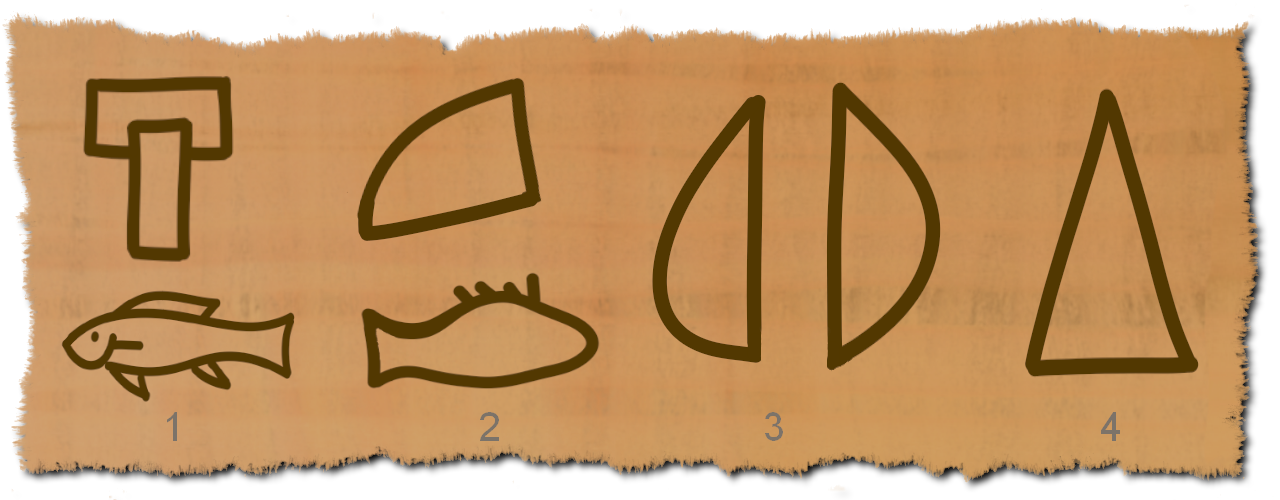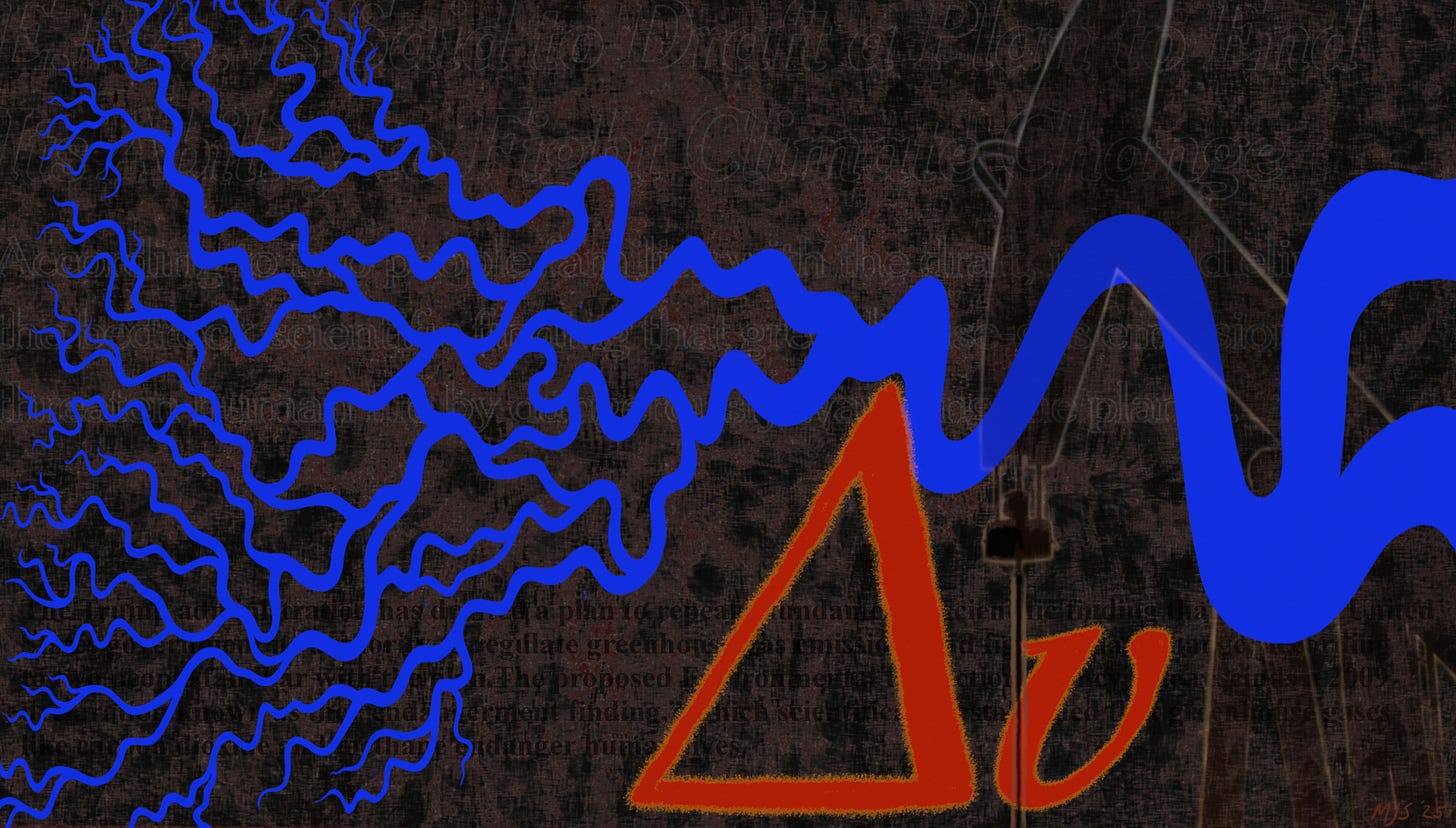Δv - Dangerous Change in Velocity
The Letter D - A Cautionary Tale for Progressive Thinkers
History
Most letters in the alphabet have a recognizable pathway from the foundational Egyptian hieroglyph to its abstracted Phoenician letter. The letter D, however, despite its relative stability in shape, has an origin story shrouded in mystery. D’s Phoenician name was dalet (or daleth), meaning door, but earlier versions of the letter do not look very door-ish. Some scholars suggest the shape came from a pictograph of a tent door. Others think that the shape originated as a fish - dag in Phoenician, and then over the years, the name morphed into dalet.
I have provided examples of some early versions of these shapes for you to draw your own conclusions.
Rounded and triangular versions of the letter appeared across the Mediterranean region before 500 BCE. When the Etruscans adopted the alphabet, the shapes stabilized into the rounded letter D in the west and the angular letter Δ in Greece.

Although the Greeks named their fourth letter delta, the word had no specific meaning to them. The modern use of the word – referring to the widening mouth of a river as it meets the sea- seems to have originated with Greek sailors who thought that the triangular shape of the Nile River’s junction with the Mediterranean Sea resembled the letter Δ.
The Painting
I was fortunate to spend many years living near the Sacramento - San Joaquin Delta in Northern California. Locals simply call it The Delta – go figure. I frequently escaped the crowded Oakland/Alameda corridor by spending lazy weekends on a landlocked houseboat nestled in a picturesque landscape dominated by meandering waterways called sloughs (pronounced slews) that surround hundreds of small islands – many of which can only be reached by boat or ferry.
Despite its idyllic isolation, humans have significantly altered the Delta over the past 150 years. Deep-water shipping channels have been cut to connect the port cities of Sacramento and Stockton with the San Francisco Bay and Pacific Ocean. The dirt from these excavations was used to build thousands of miles of levees that created privately owned island farms often 10-20 feet below sea level. Driving along some levy roads, you notice that on one side, the water level is almost equal with the road. On the other side of the road, rich farmsteads are precariously positioned nearly two stories below.
The Delta is a frequent source of dissension and controversy in California. Farmers, sportspeople, environmentalists, Northerners, and Southerners argue over recreational use, fish populations, and huge infrastructure projects. 440 miles of aqueducts bring delta water to Southern California’s 18 million people. The North’s concerns are based on the fear of repeating the extreme environmental catastrophes of the early 20th century when watersheds in the Eastern Sierra Nevada Mountains were diverted to bring fresh water to the growing Los Angeles basin. These projects turned the picturesque Owens Valley into a hellscape of dry lake beds, abandoned farms, and barren vistas that spawn toxic sandstorms at the foot of Mount Whitney, the highest point in the continental US.
Yet, whenever I visited, the Delta’s controversies simply disappeared beneath its flowing waters as I laid in the sun, listening to one of the thousand stories that old houseboat had to tell.
Driving back to the city, the Delta’s rural landscapes end abruptly near the Carquinez Straights, where large oil refineries metastasize along the horizon as the Delta empties into the San Francisco Bay. Suddenly, the sinuous rolling hills of oak grasslands sprout oil tanks resembling massive terracotta flowerpots in which the area’s majestic 500-year-old trees could fit like bonsais. This quaint visual fantasy is quickly broken by belching smokestacks and fiery gas flares that float toxins into the surrounding communities that house some of the Bay Area’s poorest residents.
Amazingly, the horrors of this landscape transform at sunset. As darkness settles, the gas flares mutate into a vivid conflagration like a Burning Man fire sculpture. The smokestacks and flare towers become ethereal skyscrapers covered in twinkling white and blue lights, creating an Oz-like cityscape nestled in shadowy hills that roll into the bay's dark waters.
The painting reflects the strange human capacity to be simultaneously repulsed by and attracted to certain images. Despite its frequently destructive nature - especially for Californians - fire is always compelling, regardless of its fuel source. Our imaginations can quickly transform a filthy, oil-encrusted pumpjack into a mythical animatronic creature rooting in the ground for its next meal.
The symbol Δv in the bottom right of the painting is mathematical shorthand for a change (Δ) in velocity (v) – often used when calculating the trajectory of a rapidly moving object, reminding us of the risks we face as our atmosphere rapidly fills with greenhouse gases. In contrast to the painting’s backdrop of environmental exploitation, the sharp blue lines of a river delta wending its way through the image speak to nature's ability to quickly heal itself when given the chance.
The image was inspired by the shock of the United States abandoning its support of environmental protection and social equity to elect an administration that promotes short-term material gains above all else. Apparently, my team's vision (the so-called liberal agenda) was so unappealing to a majority of Americans that they voted for a sociopathic felon with totalitarian ambitions. As someone who spent the past decade fighting for a balanced approach to economic growth, social equity, and environmental protection, the outcome paralyzed me for weeks.
If we want to reverse this tide (and I think we can), progressives must recognize that despite our desire to do good, our policies have been a double-edged sword. Yes, historically marginalized people have greater rights today than they did 100 years ago. But unfortunately, the soaring language of the 20th century’s great civil rights leaders is now being twisted by the MAGA right, leading some white Christians to believe that they are an oppressed minority.
Our waterways and skies are far less toxic than they were 50 years ago, but the laws that led to these victories are now being used to block the construction of solar arrays and wind farms that could help reduce carbon in the atmosphere. These same regulations are used to block affordable housing developments and multi-unit dwellings, creating cities that are too expensive for anyone without a university degree. And in these cities where the wealthiest Americans live, thousands of our fellow citizens live on the streets battling mental illness, drug addiction, and crushing despair.
Try to imagine how all this looks to someone living in a town with a boarded-up commercial district, an abandoned factory, and no meaningful employment opportunities. Would you find hope and inspiration in the liberal agenda?
Throughout history, humans have repeatedly shown that we are better at reacting to crises than preventing them. And although I am not a pessimist by nature, it seems clear that over the next few years, we will likely surge past our goals to slow global warming while also witnessing a significant regression in civil rights. To my colleagues on the left, I hope this makes you angry enough to start swimming against this tide. As we figure out a new way forward, we must be willing to critically examine the failed messaging and false assumptions that led us to this point. Our goals for a just and sustainable future will not be realized if we don’t address the genuine concerns of the people who live outside our wealthy liberal bubbles.
From an artist’s perspective, it is dangerous to use a metaphor too literally. But to finish out this essay on Δv, I will leave you with a final thought:
Deltas are places where the boundaries between land and water blur. Where salt water and sweet water mix. Where tides reverse twice a day, and no bank is safe from a storm’s swell. The beauty of this system lies not in its simplicity but in its complexity. Everything is a negotiation. It is smelly. It is chaotic. It is never the same place it was yesterday.


